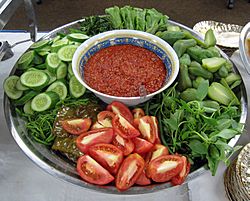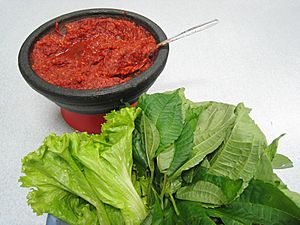Lalab facts for kids

Lalab platter with sambal
|
|
| Alternative names | Lalap |
|---|---|
| Type | Salad |
| Place of origin | Indonesia |
| Region or state | West Java, Nationwide |
| Created by | Sundanese people |
| Serving temperature | Cold or room temperature |
| Main ingredients | Various raw vegetables served with sambal terasi |
| Similar dishes | Ngapi yay, Nam phrik, Ulam |
Lalab (also called lalap or lalapan) is a fresh vegetable salad. It comes from the Sundanese region of Indonesia. This yummy dish is usually served with a spicy dipping sauce called sambal terasi.
Lalab is a very popular side dish in Indonesia. You can find it served with many main meals. Some common main dishes include ayam goreng (fried chicken) or ikan bakar (grilled fish).
Contents
What is Lalab?
Lalab is a simple yet tasty salad. It is made from different kinds of raw vegetables. There are no strict rules about which vegetables to use. Any edible vegetable can become part of a lalab dish!
Common Lalab Vegetables
Some of the most common raw vegetables in lalab are:
- Cucumber
- Tomato
- Cabbage
- Lettuce
- Lemon basil
- Leunca (a small green berry)
- Long beans
Sometimes, lalab also includes vegetables that are lightly cooked. These might be blanched (quickly boiled) or steamed. Examples include spinach, papaya leaves, and chayote.
The Spicy Dipping Sauce
The special part of lalab is its dressing. This is usually sambal terasi. It is a hot and spicy chili paste. The sambal is often served right from a stone mortar. This way, you can dip your fresh vegetables into the spicy sauce.
Where Does Lalab Come From?
The exact history of lalab is not fully known. This is because there are not many old records about it. However, we know that people in the Sundanese region have eaten fresh plants and vegetables for a very long time.
An old Sundanese book from the 15th century, called Sanghyang Siksa Kandang Karesian, talks about common food flavors. It mentions tastes like salty, spicy, bitter, sour, and sweet. These flavors often came from plants and vegetables. This shows that fresh produce was important in their diet long ago.
What's in Lalab?
Originally, lalab was made from any young leaves and raw vegetables that people could find. Today, many different vegetables are used.
Popular Lalab Ingredients
Some common ingredients you might see in lalab are:
- Sliced cabbage
- Cucumbers
- Lettuce
- Green beans
- Yardlong beans
- Tomatoes
- Leunca
- Lemon basil
- Spinach
- Water spinach
- Pohpohan leaves (Pilea melastomoides)
- Kenikir leaves (cosmos)
- Cassava leaves
- Papaya leaves
- Chayote
- Small, green eggplant
Sometimes, more unique vegetables are also used. These can include the green, strong-smelling petai and jengkol beans.
How Vegetables Are Prepared
Most lalab vegetables are simply washed in cold water and served raw. However, some can be boiled, steamed, or even fried. For example, petai beans can be eaten raw or fried. Vegetables like labu siam (chayote), water spinach, and cassava leaves are usually served boiled.
The main flavor of lalab comes from the spicy sambal terasi dipping sauce. Many recipes focus on making the perfect sambal to go with the fresh vegetables.
Why is Lalab Healthy?

Lalab is often served as a side dish with main meals like fried chicken or fried catfish. It is packed with good things for your body!
Nutrients in Lalab
Lalab is rich in:
- Vitamins: These help your body grow and stay healthy.
- Minerals: Important for strong bones and many body functions.
- Fiber: This helps your digestive system work well.
Eating fresh vegetables every day is great for your health. It can help lower cholesterol levels. It also makes your digestion better. Vegetables are full of antioxidants. These are special helpers that protect your body's cells. They can help fight off harmful things called free radicals. Some plants used in lalab are even believed to have special medicinal benefits.


